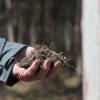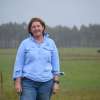
ActivAcre hits milestone, calls for more farmers to get on board
Posted 19 December 2024
Economic benefits and markets Carbon benefits PFT
A Tasmanian carbon forestry initiative has marked a major milestone, with more than one
million trees planted on almost 1,000 hectares of land across the state, estimated to sequester
more than 300,000 tonnes of CO2 from the atmosphere.
The ActivAcre program, delivered by Tasmanian plantation and natural asset management company SFM, collaborates with farmers to identify opportunities for them to lease land for tree planting.
SFM Managing Director Andrew Morgan said the local initiative allowed farmers to optimise their land and diversify their on-farm revenue, providing them with a reliable source of income.
“But of course the benefits of ActivAcre flow well beyond the farmer – plantation forestry is recognised globally as a key tool to mitigate climate change, capturing carbon in soil and vegetation,” Mr Morgan said.
“Further to this, Australia currently has a $4 billion trade deficit in wood products, yet we have a skilled workforce with world-class infrastructure and high-quality governance, so we have a real opportunity to turn the situation around.”
Mr Morgan said across Australia, sourcing larger parcels of suitable land was becoming harder, making aggregation essential, where multiple smaller land holdings are classed together to make one asset.
“With the successful completion of our first full year of planting and our 2025 program nearing capacity, we are now seeking expressions of interest from landowners for our 2026 planting” he said.
“Today we held an open ‘field’ day on the Bloomfield property in Gretna for interested landowners and farmers to learn more, ask questions and see a plantation carbon project first-hand.”
Bloomfield owners Susie and Michael Parsons signed up to the ActivAcre program earlier this year.
Susie Parsons said the seven-generation farming family was already benefiting from the financial return of leasing their land and could see the future opportunities it presented, both for their own property and for the environment.
“The additional value proposition of planting trees is the creation of shade and shelter belts, which can increase pasture production as well as improving water efficiency, soil quality and reducing salinity, waterlogging and erosion,” Mrs Parsons said.
Mr Morgan said the future-focused land management program worked closely with farmers to create unique and flexible agreements to maximises their land's potential and ensure an ongoing, reliable income every year from planting to harvesting.
“ActivAcre is unique in that every aspect of the project, from initial enquiry to carbon project registration to final plantation harvesting, is managed by SFM’s local team of highly experienced foresters, land management professionals and carbon project experts, all of whom have a deep understanding of the Tasmanian agricultural landscape,” he said.
Tasmanian farmers and landowners can find out more at: activacre.com.au
Share this Article
Latest Articles
-

20 October 2025
Tasmanian High Soil Carbon Landscapes project
-

17 September 2025
Celebrating excellence at the Tasmanian Timber Awards
-

17 September 2025
Forest Practices Authority Research Update Day
Archives
- ActivAcre hits milestone, calls for more farmers to get on board
- Napier's leading the way in sustainable forestry and carbon-neutral farming
- Sound science needed to assess carbon impacts of timber harvesting
- Newly appointed TFFPN Board of Directors
- Graduate Certificate of Forestry Scholarship
- Forestry Australia Mentoring Program 2025
- Forest Industry Roundtable planning for the long term
- Eagle Management Constraint Period extended
- Successful private native forest management celebrated
- $15 million investment in new ship loader to boost Bell Bay's forestry exports
- Standing with Tasmania's forestry industry: buy local
- TFPA: Tasmanian Freight Equalisation Scheme needs a ground-up review
- AFCA Gala Dinner celebrates industry excellence
- Fire permits now required Statewide
- Forest leaders hone skills in sustainable native regrowth management
- Tasmanian forests and the carbon market: Barriers and opportunities
- What the 2024-25 Tasmanian Budget means for forestry
- Spring is the time for fuel reduction burning
- Primed for Growth: A situation analysis of the Tasmanian Forest and Wood Products Sector
- Audit requirements cut for low-risk plantation projects
- Guidance and support for landowners after damaging winds
- Forestry Australia welcomes further definition of active forest management
- Farm & Forest Mapper Tool highlighted at Rural Youth Tasmania's Young Farmer of the Year competition
- Senate Select Committee inquiry into the Tasmanian Freight Equalisation Scheme
- Timberlink announces new wood composite products brand
- Newly developed protocol a vital tool for safeguarding forestry industry
- Red Hot Tips: Fire management for Tassie farmers
- Bioenergy: Fuelling industries with trees
- Harvesting trees: What you need to know
- Shelterbelts: How are they contributing to farm systems?
- Infill plantings and remnant vegetation: Why biodiversity depends on a thriving understory
- Plantation planning: The key to a successful plantation
- Exciting interactive forestry knowledge hub launched
- $450,000 farm forestry grant recipients revealed


